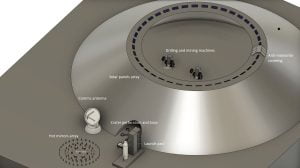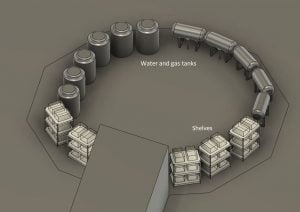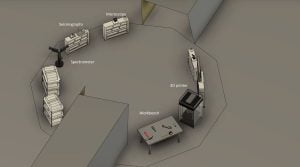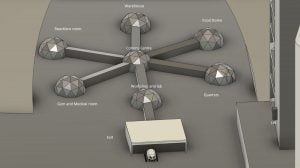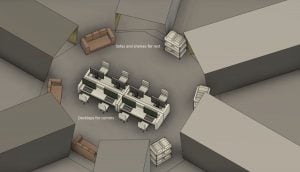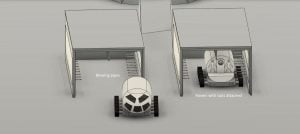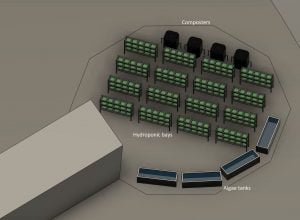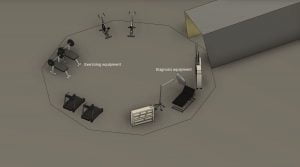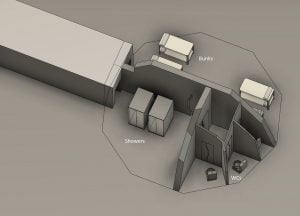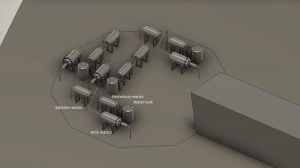Moon Camp Pioneers Gallery 2020-2021
In Moon Camp Pioneers each team’s mission is to 3D design a complete Moon Camp using Fusion 360. They also have to explain how they will use local resources, protect astronauts from the dangerous of space and describe the living and working facilities.
Team: Calatalifa
Calatalifa Villaviciosa de Odón Spain 16
External viewer for 3d project
|
Project description
PIONEERS project (Permanent International COlonies Near CratErs Exploiting lunar ReSources) seeks to establish a long-term stay on the Moon by using a closed ecological cycle and communal lunar resources, thus allowing several almost-independent bases to be built. In order to achieve this, a radially symmetrical base will be built inside the wall of a lunar crater in the South Pole, such as Shackleton. Water will be extracted and used as the starting point of a series of processes that will enable to grow food, reobtain nutrients, and produce essential gases, such as carbon dioxide, oxygen, hydrogen, or nitrogen. The crater walls´ peaks will house solar panels to ensure constant electrical supply, which could be shared among several bases. These will be covered in case of meteoric hazards, which will be detected with anticipation. Eight icosahedral domes will provide different functions and house up to eight people, who will be using it to investigate nearby areas with rovers, manufacture low-gravity products to obtain funds for maintenance, and carry different experiments to explore new technologies suitable for life on the Moon. Furthermore, it will also be used as a spaceport to depart to Mars in the future. In situ production of different substances, including oxygen, methane and hydrogen, will enable to fuel spacecraft if needed. Overall, the base would be a stepping stone for establishing independent large-scale colonies which can reuse their resources and tap into the local ones, while at the same time providing scientific and commercial return. |
|||
|
Where do you want to build your Moon Camp?
The Moon Camp would be built inside the walls of a South Pole crater, such as Shackleton. This way, it would be protected against radiation and meteoritic hazards, while at the same time it would enable several bases to be built around it. Given its great width compared to the base, this would enable future expansions in order to house more people. The crater would be used to obtain ice, which would provide hydrogen, oxygen, and water. Additionally, the so called peaks of eternal light would be used to achieve a constant electrical production with solar panels that could be shared, thereby reducing competition for colonising this area and encouraging cooperation. How do you plan to build your Moon Camp? Describe the techniques and materials you would use.
The base would consist of seven icosahedral domes connected by tubes to improve stability, since they consist of equilateral triangles made up of HY alloys to withstand pressure along with a scratch-resistant plastic cover, especially for outer areas, as well as a rover garage. These plates would be sent to the surface in addition to RTG- powered mobile machinery that would enable to drill the necessary space. This would also serve as a preliminary mission to test the procedures and technologies. Additionally, its tyre system could be turned vertically and deploy pipes for distributing ice. It would run over the crater´s upper walls, and then descend back to the base. Also, antennae for communication would be sent. Over time, as human presence increases, more complex systems could be built to connect several bases. Regolith would be extracted in situ to form protective coatings that could be deployed in case of detecting any potential hazard. They would be processed and used as a 3D- printer material by these polyvalent machinery. In order to reduce the costs of this preliminary phase, an international program would be needed, along with the usage of reusable launchers. The environment on the Moon is very dangerous for the astronauts. Explain how your Moon Camp will protect them.
In order to reduce radiation exposure, the base would be buried inside the crater´s wall with a small, regolith-covered exit where rovers would be deployed. These would be covered by radiation-resistant material, and would have lunar suits attached to them in such a way that lunar dust can be removed from the back part. Additionally, the rovers would be inside an outer chamber connected to the base, where they would be maintained. Dust would be removed from its surface by pumping excess carbon dioxide to the vehicles, and then it would be filtered. Rovers could also be remotely operated for reconnaissance operations to avoid exposure. Deployable regolith ceilings would be built in sensible areas, such as solar panels, if any hazard were detected through satellite observation. Lastly, to reduce the low gravity´s impact, there would be a space devoted to physical activity. Explain how your Moon Camp will provide the astronauts with:
|
|||
|
Water
|
Food
|
Electricity
|
Air
|
|
Water would be extracted in the form of ice from the crater´s depression, and would be transported to the base´s outer area, where it would be melted with hot mirrors. A part of it would be used in hydroponic tanks, and could also be obtained as a waste-product from decomposer organisms that feed on plants´ remains. Expelled carbon dioxide from astronauts would be processed in the Sabatier reaction to obtain yet more water, as well as in the water-gas-shift reaction. Water obtained as vapour would be cooled and pressurised to liquefy it. |
One of the domes would house hydroponic tanks where several kinds of plants would be raised: soya, chickpeas and peanuts for proteins and fat; potatoes for carbohydrates; and green-leafed plants such as spinaches for useful minerals such as calcium, crucial to avoid osteoporosis. Diatoms would be raised as well to remove carbon dioxide and produce oxygen along with multicellular algae. Decomposer fungi and bacteria would feed on plants´ remains in dark chambers as an additional source of proteins and to produce water and carbon dioxide and nitrogen, which would be captured and sent back to the plants, recreating a nitrogen cycle to reduce the need of imported substances needed for plant growth. |
Power would be mainly generated by solar panels deployed all around the crater´s wall peaks, to provide constant supply even at dark periods of the lunar cycle. It would also be distributed among several bases when they were built. Hydrogen obtained from water electrolysis and WGS could also be used in fuel cells to obtain more energy. Other additional sources of energy would be heat generated by the compost chamber, and methane generated by the Sabatier process, which could be stored as fuel or burnt. |
Several reactions would be used to obtain different kinds of gases. Ice would be electrolyzed to obtain oxygen and hydrogen, which would have several uses as stated above. Oxygen would be consumed by residents and organisms in the composter, obtaining nitrogen by filtering its waste products. At first, nitrogen and oxygen would be imported from Earth to establish the base´s atmosphere, but could be produced at a small scale by farming through decomposers, plants and algae, respectively. Carbon dioxide would be used in Sabatier´s reaction to obtain water and methane, and would also be used to remove dust from rovers. Overall, the atmosphere would be monitored continuously by sensors to detect any possible leak, and imported reserves would be stored in case of any accident. Any harmful gas, such as CO from WGS, could be released to the atmosphere and be removed by solar wind. |
|
Explain what would be the main purpose of your Moon Camp (for example: commercial, scientific, and/or tourist purposes).
The camp would perform several functions simultaneously. It would be an international, scalable experiment to try different procedures and strategies to establish stable, independent bases that could share local resources via a connected network. Additionally, large-ranged expeditions both remotely and through EVAs would provide invaluable knowledge of the Moon´s geology, not only at the surface level, but at deeper levels too through the drilling machines. It could also be used to investigate low-gravity applications and products and export them to lower the overall costs, providing varied scientific knowledge. In the long term, it could be used as a future launching point for missions to Mars thanks to its low gravity and in-situ propellant manufacturing. |
|||
|
Describe a day on the Moon for your Moon Camp astronaut crew.
The crew would wake up after periods of 8-9 sleep hours, although a pair of astronauts would keep guard on the communications room, contacting both the Earth and other nearby bases if necessary. These pairs would rotate regularly, and would be allowed to rest during daytime for the rest of the crew. There would be a general scanning procedure, and afterwards the crew would devote their time to different scientific experiments depending on their specialty. For instance, geologists may perform EVAs or operate rovers remotely; botanists could supervise the crops and perform low-gravity experiments on the lab; engineers could monitor the reactions and help repair any leak, and so on. After seven hours of work, the crew would gather at the central room to have lunch and have two hours off, when they could exercise on the gym, have medical check-ups, relax at the central room, etc. Then, data analysis from retrieved material or performed experiments would be done, along with maintenance labours such as revising the composter, cleaning the rovers, and so on. Overall results would be sent at the end of the day as a daily report, revising aspects such as the feasibility of manufacturing processes, experiments, suggestions, etc, and would receive instructions from Earth. However, the channel would be open continuously and would be monitored accordingly. If any supply were needed, the base would request a cargo mission, and reusable launchers would carry supplies that would descend to the surface, or in the case of more delicate material, they would land near the entrance, be refuelled, and leave. If any emergence took place in other bases, the crew could get there through their rovers to provide assistance, ensuring fast responses until further help came from the Earth if it were needed. |
|||


